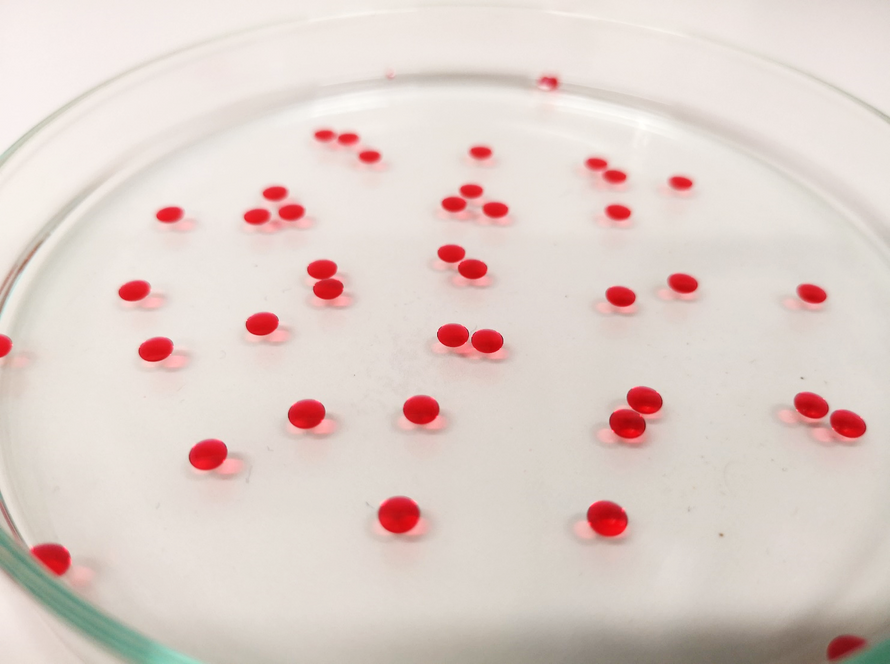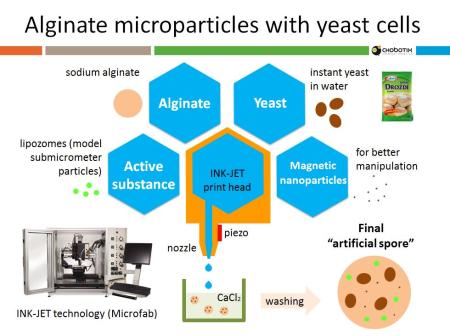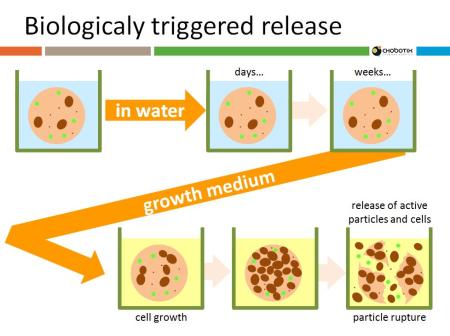
Research
- We are a lab focused on wet artificial life
- We study droplets as liquid robots and other droplets
- We are interested in chemobrionics and other self-organizing chemical systems
- We also study liquid marbles
- Our lab is located in room BS62

In our laboratory, we focus on long-term studies of decanol droplets in sodium decanoate solution. These simple systems exhibit chemotactic movement, collective behavior, and shape changes that resemble features of living organisms.
One of the fundamental properties of living organisms is the ability to sense and respond to changes in their environment by movement. If a motile cell senses soluble molecules and follows along a concentration gradient to the source, or if it moves away from a source of undesirable chemicals (e.g. repellent, toxin), it is displaying a directional movement called positive or negative chemotaxis, respectively. This phenomenon is well-known to biologists and intensively studied in living systems. Recently we have shown that decanol droplets in the presence of aqueous solution of sodium decanoate are able to follow the additions of sodium chloride. This kind of artificial chemotaxis has been observed in both narrow channels and topologically complex systems, such as maze.
Pattern formation in far from equilibrium systems is observed in several disciplines including biology and reaction-diffusion chemistry, comprising both living and non-living systems. We aim to study such non-equilibrium dynamics of a novel system based on a 1-decanol droplet placed in a solution of alkaline decanoate. Recently, we have found that when the system is open to the environment and the evaporation of water from decanoate solution occurs we observe dramatic morphological changes of the decanol droplet. Moreover in the presence of sodium chloride it shows a novel type of pattern formation, namely the formation of long tentacular structures that we aim to analyse within present project at both the macroscopic and microscopic scale across a large range of initial conditions. Such reproducible morphological changes in simple droplets open a path for exploration of shape-based effects in larger scale pattern formation studies.
Although the single droplet behaviour has been studied in detail already, the collective behaviour of decanol droplets has not been analysed yet and we focus on the description, how decanol droplets in decanoate solution interact between each other and how the presence of other droplets and environmental conditions influence their behaviour.
The word “robot” was first introduced in 1921 in a Czech play R.U.R. - Rossum’s Universal Robots, where robots are not clanking metal constructions, but human-like beings made of soft matter with no wheels, no electric power and no computer systems to control them. They are based only on chemical principles and consisting of colloidal substances. The author of the play, Karel Čapek, describes them as being made of a protoplasm - a substantive essence of living matter (…“a blob of some kind of colloidal jelly that even a dog wouldn’t eat”…). In this way we can consider a droplet based on chemical principles and activated through fluid dynamics to be an embodiment of robotics more sympathetic to Čapek’s original conception. We introduce droplets as animated soft matter. We argue that droplets can be considered as liquid robots possessing some characteristics of living systems. In particular, the life-like properties and behavior of liquid robots, such as autonomous movement, self-division, ability to change shape, group dynamics and collective swarm behavior are discussed.
In 2017, we proposed the term liquid robots for droplets exhibiting life-like behavior. A year later, our publication on this topic was awarded Best Paper by the International Society for Artificial Life. In 2020, to mark the 100th anniversary of the word robot, Jitka published the book Robot 100 in Czech; the English edition was published by MIT Press in 2024.
Chemobrionics is a key area of systems chemistry, helping us understand complex self-assembling structures relevant to both the origin of life and the development of advanced materials. In our lab, we focus on chemical gardens, especially on crossing different types of seeds from various salts to observe the emergence of new “chemical plants” — a kind of chemical Mendelian experiment. We also created the short film Chemobrionics, and Jitka Čejková served as working group leader and science communication coordinator in the European COST Action on chemobrionics, as well as editor of a special journal issue on the topic.
Student Mathis Leemann from Switzerland made in collaboration with Jitka Čejková and Jan Havlík a short film titled "Chemobrionics". This film had a world premiere at the 25th Ji.hlava International Documentary Film Festival in the section Fascinations: Exprmntl.cz.
The subtitle of this 5-min length audio-visual chemobrionics-related project is a quotation by Cicero and it was chosen with the aim to show, that in the same way as Roman garden was designed for thinking, philosophizing and discourse, the chemical gardens can also open the door to philosophical questions such as what life is and how it originated, how we distinguish the biological systems from their chemical counterparts. Our video focuses on showing the beauty of silicate chemical gardens composed of plant-like tubular structures made of metal salts placed in a water glass. The viewer is be puzzled by the hypnotic slow growth of the structures and the manifold of colors they can produce. Tiny aerial air bubbles, flowing inner solutions, thick and alien-like structures changing colors let the audience perplexed, dreamy, wondering why nature is presenting such delightful sight. Furthermore, extracts of Doctor Faustus by Thomas Mann, The Origin of Life by John Desmond Bernal and Mechanism of life by Stéphane Leduc are added to deepen the experience. The inspiration for this audio background was taken from Julyan Cartwright’s works focused on the chemical gardens, their history and mentions in the literature.
Director and producer: Jitka Čejková
Editor: Mathis Leemann
Camera operator: Mathis Leemann, Jan Havlík
Experiments: Mathis Leemann, Jan Havlík, Saniya Ustunn
Voice: Declan Garvey
Music: Chopin - Raindrop Prelude (Op. 28 No. 15), performed by Petr Mazúr
This film is based upon work from COST Action CA17120, supported by COST (European Cooperation in Science and Technology). COST is a funding agency for research and innovation networks. Our Actions help connect research initiatives across Europe and enable scientists to grow their ideas by sharing them with their peers. This boosts their research, career and innovation.
A liquid marble is a liquid droplet encapsulated in a hydrophobic powder that adheres to the liquid surface. In our laboratory, we study liquid marbles as innovative micro‑bio‑reactors for bacterial cultivation and explore oil-based liquid marbles for advanced applications.
A liquid marble is a liquid droplet encapsulated in a hydrophobic powder that adheres to the liquid surface. Liquid marbles preparation is very simple – a small amount of liquid is rolled on the layer of hydrophobic powder consisting of nano- or micro particles, which spread spontaneously at the interface liquid / air. This process results in a liquid marble formation that has some of the properties of a liquid droplet and at the same time it behaves as a soft solid. Liquid marbles are an alternative to superhydrophobic surfaces, because particles preventing the liquid to wet and contaminate the carrier surface which can be a solid or liquid surface. The present work focuses on the description of basic properties of liquid marbles and also gives an overview of the possible applications of liquid marbles, e.g. for transport of small volumes of liquids or powders in microfluidics, for the detection of gases or water contamination or as (bio)microreactors.
In the past, our lab focused extensively on pattern formation in Dictyostelium discoideum. Although we are no longer actively running experiments with this fascinating microorganism, we have collected a range of interesting results and videos. We remain open to discussions and collaborations related to this topic.
Dictyostelium discoideum is a microorganism that under normal conditions consists of independent single amoebas and under unfavourable conditions, these cells become “social” and enter a multicellular developmental program. After the initiation of starvation, pioneer cells release pulses of cyclic adenosine-3‘,5‘-monophosphate (cAMP). Nearby cells sense this compound and start to move chemotactically in the direction where the cAMP concentration rises most rapidly. By using chemotaxis, cells aggregate into multicellular object enabling them to survive unfavourable conditions.
We are currently focusing on cell encapsulation as part of the INTER-MICRO project, which aims to study microbial communication. In our lab, we encapsulate yeast cells in alginate, and have demonstrated biologically triggered release from the capsules.
A new method for triggering the burst liberation of encapsulated sub-micron particles from carrier particles using embedded microorganisms has been developed. Triggering mechanisms such as those based on chemical, light, thermal, or magnetic stimuli are known, but man-made particles are not yet able to replicate the concept of “dormancy” found in biological systems in the form of spores or seeds that survive in an inactive state and start to grow only once favourable environmental conditions are encountered. An engineered particle system that mimics this property by embedding viable yeast cells into synthetically made alginate microcapsules is reported in the present work. Cell growth and division is used as a triggering mechanism for stimuli-responsive release of the encapsulated content. The hybrid living/artificial capsules were formed by an inkjet printing process and the mechanism of biologically triggered release was shown using fluorescently labelled liposomes.

